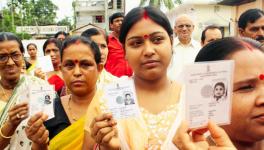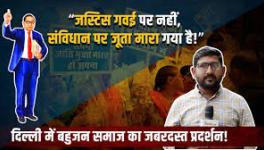Thokne Wali Sarkar Eats Humble Pie in Lakhimpur Kheri
Uttar Pradesh under Chief Minister Adityanath was styled as “thokne wali sarkar” or government that hammers not just criminals but also recalcitrant citizens and dissidents. This boast was found hollow in 24 hours of the violence erupting in Lakhimpur Kheri, where four farmers were mowed down by a convoy of vehicles. One of these vehicles allegedly had at its wheel Ashish Mishra, son of Union Minister Ajay Mishra.
The government promised to pay Rs. 45 lakh to each of the families of the dead, booked Ashish Mishra for murder and promised a swift investigation by a senior High Court judge. It was only then the farmers cremated three of the four victims. Farmer leaders, however, said they expected the government to arrest Ashish in a week or so.
The Adityanath government’s placatory attitude to the farmers is in sharp contrast to the stance it had adopted, in December 2019, against those who took to the streets to protest against the Citizenship Amendment Act. Then the Uttar Pradesh Police had fired upon protesters at several places, killing 22.
In subsequent weeks, over 10,000 FIRs were filed, 500 minor children detained, and 500 notices issued for recovery of money from those accused of destroying public property. Billboards displaying photos of civil society activists accused of instigating violence sprang up in Lucknow.
Adityanath’s climbdown in Lakhimpur Kheri has been undoubtedly influenced by the state Assembly election due early next year. It is also true these farmers are not Muslims, making it immensely difficult for the Bharatiya Janata Party to demonise them as anti-national. BJP followers have periodically tried, as they also did at the outbreak of the violence in Lakhimpur Kheri, to portray the farmer movement as a conspiracy of Khalistanis. This narrative has had few takers in Uttar Pradesh because of Rakesh Tikait being counted among the spearheads of the farmer movement.
It has to be seen whether the image of Adityanath leading a “thokne wali sarkar” will take a further beating, for the farmers are insistent upon the arrest of Ashish Mishra. His vehicle, as seen in videos, drove over farmers; he is also alleged to have also shot at them. Ajay Mishra has claimed his son was elsewhere at the time the incident occurred. The Indian Express, in its editorial, said a fair probe in the Kheri violence is not possible without Mishra senior resigning from the Union Ministry.
The Mishras are Brahmin; their caste identity may still save them. Given that the Brahmins are seemingly upset with Adityanath, a Rajput, for supposedly discriminating against them, punitive action against the Mishras will risk further alienating the powerful community. On the other hand, inaction will prompt the farmers to intensify their stir in Uttar Pradesh, a scenario disadvantageous to the ruling party before the Assembly elections.
It was Mishra Senior who provided the spark that lit the fire in Lakhimpur Kheri. In a video released after farmers showed him black flags in Palia, which falls in the parliamentary constituency of Kheri, where he had gone on a visit, Mishra had threatened, “Face me, it will take just two minutes to discipline you fellows. I am not only a minister or a MP and MLA… People who know me even before I became a Parliamentarian know that I never run away from taking a challenge. The day I accept the challenge you all have to leave not only Palia but Lakhimpur itself.”
It is unbecoming of a Union Home Minister to speak in the language that was typical of feudal upper-caste landlords of yore. The alleged crime of Ashish driving over farmers with his vehicle is also reminiscent of the barbaric oppression associated with feudal lords. Their caste privileges provided them immunity from the violence they perpetrated.
The penchant of BJP leaders for violence is not just confined to Uttar Pradesh, which in the Hindutva imagination is considered a prototype of Hindu Rashtra. Take Haryana Chief Minister Manohar Lal Khattar, who, only last week, was caught in a video encouraging the raising of groups of volunteers in every district and advocating that they should take on the protesting farmers in a tit-for-tat policy.
Khattar also said volunteers should not apply for bail if they are arrested, for a spell of one, two, or six months in jail will turn them into big leaders. The Haryana administration later clarified that Khattar had also asked these groups to maintain discipline, which he defined thus: “Along with enthusiasm, you must maintain discipline. If you are told to do something, and to not do more, you must stick to that.”
Khattar’s idea of violence and discipline mimics the code of the gang of lathaits, or club-wielding toughies, whom feudal lords would rear. They were allowed to engage in violence only on the landlord’s instruction, often to suppress the tillers of land or enforce oppressive caste rules. Such gangs are still not too uncommon in parts of rural India.
It may seem inexplicable why BJP leaders, in control of the levers of State power, should favour the raising of armed vigilante groups. We have had Hindutva groups lynching those suspected of consuming beef or ferrying cattle to slaughterhouses. Last Sunday, a mob vandalised a church in Roorkee, Uttarakhand, and attacked those attending the Sunday prayers. The assailants said they suspected a conversion ceremony was underway.
The mission of Hindutva groups and their masters is to terrorise religious minorities and marginalised social groups into conforming to the Hindu social code as visualised by Hindutva. This is sought to be attained through laws such as those proscribing conversion and cattle slaughter.
But the impact of laws is limited, for these the State can invoke only when there is prima facie evidence of the culpability of specific individuals. Its action based on mere suspicion is decried as an example of State high-handedness.
This limitation vigilante groups do not suffer from. The randomness of their violence, as in Roorkee, is a coded threat to the entire social group—they must conform to the Hindu social code or risk retribution. It was precisely this principle that made the landlord’s gang of lathaits menacing enforcers of caste rules.
This age-old principle has been reconfigured in India’s democracy. Those holding the levers of the State know it is terrible for their image to deploy brute force to crush dissent. The business of compelling compliance is, therefore, contracted out to vigilante groups. This was precisely the method adopted to crush the sit-ins against the Citizenship Amendment Act. Hoodlums carrying backpacks, with their faces masked, triggered the violence that the police allowed to spiral out of control. It was more or less the method adopted to spark the violence in Bhima Koregaon in 2018.
Khattar’s suggestion to his followers to organise voluntary groups is designed to implicate peaceful protestors in episodes of violence and delegitimise them. Violence spawns anxiety and fear in the society about instability and chaos. A State crackdown on dissenters and protesters acquires social legitimacy. It also enables the BJP to polarise the electorate. Indeed, the Indian State is the upper caste feudal landlord who brooks no opposition and wishes to protect a social order with all its caste and class inequalities.
(The author is an independent journalist. The views are personal.)
Get the latest reports & analysis with people's perspective on Protests, movements & deep analytical videos, discussions of the current affairs in your Telegram app. Subscribe to NewsClick's Telegram channel & get Real-Time updates on stories, as they get published on our website.























